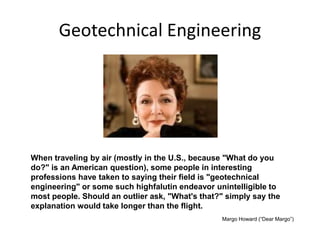The 7-Minute Rule for Geotheta
The 7-Minute Rule for Geotheta
Blog Article
Geotheta Can Be Fun For Anyone
Table of ContentsThe Basic Principles Of Geotheta Some Known Details About Geotheta The 30-Second Trick For GeothetaAll about GeothetaGeotheta for Dummies

They conduct website examinations, gather samples, execute laboratory tests, and analyze data to review the suitability of the ground for building and construction projects - Geo Tech Engineer. Based upon their findings, geotechnical designers provide suggestions for structure design, slope security, keeping structures, and reduction of geotechnical risks. They team up with various other specialists, such as architects, architectural engineers, and building groups, to guarantee that geotechnical factors to consider are incorporated right into the total project style and application
By assessing the actions and properties of dirt and rock, they can identify potential geotechnical hazards such as landslides, soil negotiation, or slope instability. Their proficiency assists prevent failings or mishaps that might jeopardize lives and property. Below are some thorough tasks and obligations of a geotechnical designer: Website Examination: Geotechnical designers conduct site investigations to gather data on subsurface problems.
They interpret the data to understand the properties and habits of the dirt and rock, including their toughness, permeability, compaction qualities, and groundwater conditions. Geotechnical Analysis and Design: Geotechnical designers examine the information gathered throughout website examinations to evaluate the stability and viability of the website for construction jobs. They perform geotechnical estimations and modeling to examine elements such as bearing capacity, negotiation, incline stability, lateral earth pressures, and groundwater flow.
Geotheta Can Be Fun For Anyone
Foundation Design: Geotechnical engineers play a critical function in creating structures that can securely sustain the intended structure. They analyze the soil conditions and load needs to identify the appropriate structure type, such as superficial structures (e.g., footings), deep structures (e.g (https://old.bitchute.com/channel/GgOXLypkqwPa/)., heaps), or specialized strategies like dirt enhancement. They take into consideration elements such as settlement limitations, bearing capacity, and soil-structure communication to create optimum foundation styles
They evaluate construction strategies, display site tasks, and carry out area inspections to validate that the style suggestions are followed. If unpredicted geotechnical problems occur, they assess the scenario and offer recommendations for remediation or changes to the style. Danger Analysis and Mitigation: Geotechnical designers examine geotechnical risks and risks associated with the job site, such as landslides, liquefaction, or soil erosion.

Collaboration and Interaction: Geotechnical engineers function closely with other specialists entailed in a job, such as designers, architectural engineers, and building teams. Efficient communication and collaboration are vital to integrate geotechnical factors to consider right into the general job design and building procedure. Geotechnical engineers offer technological know-how, answer queries, and ensure that geotechnical requirements are satisfied.
Unknown Facts About Geotheta
Below are some kinds of geotechnical engineers: Foundation Designer: Structure designers concentrate on developing and assessing foundations for structures. They analyze the dirt conditions, load demands, and site features to determine the most proper foundation type and style, such as shallow foundations, deep foundations, or specialized techniques like pile structures.
They review the elements influencing incline stability, such as soil residential properties, groundwater problems, and slope geometry, and develop methods to prevent slope failings and alleviate dangers. Quake Designer: Quake engineers focus on examining and developing structures to stand up to seismic forces. They examine the seismic hazard of a website, examine soil liquefaction potential, and create seismic design requirements to make sure the safety and security and durability of frameworks during quakes.
They execute area screening, gather samples, and examine the collected information to identify the soil buildings, geologic developments, and groundwater conditions at a website. Geotechnical Instrumentation Designer: Geotechnical instrumentation engineers concentrate on tracking and determining the habits of soil, rock, and frameworks. They mount and preserve instrumentation systems that monitor elements such as dirt negotiation, groundwater degrees, slope motions, and structural variations to evaluate efficiency and supply early cautions of possible issues.
6 Simple Techniques For Geotheta
They perform tests such as triaxial examinations, loan consolidation tests, straight shear tests, and leaks in the structure tests to gather data for geotechnical analysis and layout. Geosynthetics Designer: Geosynthetics designers specialize in the style and application of geosynthetic materials, such as geotextiles, geogrids, and geomembranes. They use these products next to improve dirt security, reinforce slopes, provide drain solutions, and control erosion.
They have a tendency to be investigative people, which suggests they're intellectual, reflective, and curious. They wonder, systematic, rational, analytical, and logical. A few of them are also social, suggesting they're kind, generous, cooperative, person, caring, valuable, understanding, tactful, and friendly. Does this seem like you? Take our complimentary occupation examination to locate out if geotechnical engineer is one of your top occupation matches.
In the workplace atmosphere, geotechnical designers use specialized software application tools to do computations, create styles, and evaluate data. They prepare reports, evaluation project specs, communicate with clients and staff member, and coordinate job activities. The workplace setup offers a helpful setting for research study, analysis, and collaboration with various other experts associated with the project.
The Ultimate Guide To Geotheta
They often visit job sites to carry out website investigations, evaluate geotechnical problems, and gather data for evaluation. These brows through include taking a trip to various locations, sometimes in remote or difficult surfaces. Geotechnical designers may perform soil tasting, conduct tests, and screen construction tasks to make sure that the geotechnical facets of the project are being carried out correctly.
Geotechnical designers additionally work in specialized geotechnical laboratories. Geotechnical lab designers work thoroughly in these atmospheres, taking care of testing equipment, operating instruments, and recording data.
Report this page